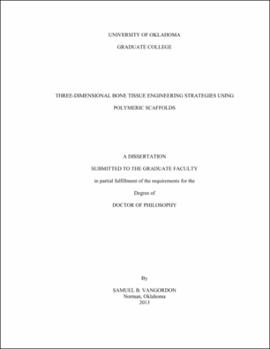| dc.contributor.advisor | Sikavitsas, Vassilios I||Papavassiliou, Dimitrios V | |
| dc.creator | VanGordon, Samuel Burton | |
| dc.date.accessioned | 2019-04-27T21:40:46Z | |
| dc.date.available | 2019-04-27T21:40:46Z | |
| dc.date.issued | 2013 | |
| dc.identifier | 9981478302042 | |
| dc.identifier.uri | https://hdl.handle.net/11244/319333 | |
| dc.description.abstract | Bone tissue engineering has emerged due to a lack in effective and convenient bone graft alternatives to treat skeletal defects. This has lead to research into materials and methods with the goal of producing viable bone tissue grafts. These methods of research combine the major components of tissue engineering: cells, scaffolds, and stimuli from chemical and mechanical means. Polymer materials have provided many options in the way of scaffold design and function. In this manuscript, 4 various studies examine the use of polymer scaffolds employed in bone tissue engineering applications. | |
| dc.description.abstract | New porous polyetheretherketone(PEEK) foams were investigated as new biomaterial scaffolding for medical bone tissue applications. When the porous PEEK material was cultured with mesenchymal stem cells (MSC) statically using osteogenic media (α-minimal essential media (αMEM) supplemented with dexamethasone, ascorbic acid and β-glycerophosphate) it was discovered that this new form of PEEK had the same osteocondutive properties to that of conventional PEEK. The architecture of the new PEEK lacked an interconnected pore network desirable for bone neotissue formation and was only 50% porous. The generated porosity also reduced the mechanical properties of the material. It was found that this new porous PEEK would be useful as an implant in areas that require reduced modulus or tissue ingrowth at the surface. | |
| dc.description.abstract | Preosteoblastic MSCs seeded onto poly(lactic acid) (PLA) scaffolds have been found to be able to differentiate along the osteoblatic lineage when cultured in flow perfusion bioreactors. A study was performed to investigate the influence of polymeric scaffold architectures on the development of MSCs cultured in perfusion bioreactors. It was found that non-woven PLA fiber mesh scaffolds had accelerated tissue formation and ostoblastic differentiation over porous PLA foams within 4 days. These effects were diminished by 8 days of culture. | |
| dc.description.abstract | While perfusion bioreactors have been shown to encourage cellular proliferation, osteogenic differentiation, and tissue formation, accelerated flow rates can detach cells from the surface of PLA scaffolds. Porous foam PLA scaffolds were seeded with MSCs by static and oscillatory dynamic seeding. Cell seeding was performed with either basic α-minimal essential media or osteogenic media. Seeded scaffolds were then subjected to a 1 mL/min/scaffold unidirectional flow in order to detach cells from the surface of the scaffold. It was found that seeding efficiencies differed due to seeding method and what media was used. During detaching flow experiments, scaffolds seeded dynamically using osteogenic media were able to withstand fluid shear up to 48 hours from elevated unidirectional flow. While, scaffolds seeded dynamically with αMEM had 78.4±7.5% of its originally attached cells detached after 48 hours of fluid flow. | |
| dc.description.abstract | Lastly, in order to seek a method to be able to nondestructively assess constructs generated for bone tissue engineering, conventional high resolution microcomputed tomography (μCT) was coupled with computer image processing techniques to produce a method of virtual histology. The computational techniques were able to segment and identify MSCs seeded dynamically upon a PLA non-woven fiber meshes. To further test the virtual histology technique, a construct composed of PLA non-woven fiber scaffold, cells, soft tissue and mineralized tissue was imaged using μCT and the components of the construct were sectioned apart without destroying the construct. | |
| dc.format.extent | 147 pages | |
| dc.format.medium | application.pdf | |
| dc.language | en_US | |
| dc.relation.requires | Adobe Acrobat Reader | |
| dc.subject | Tissue scaffolds | |
| dc.subject | Tissue engineering | |
| dc.subject | Biomedical materials | |
| dc.subject | Bone regeneration | |
| dc.title | Three-Dimensional Bone Tissue Engineering Strategies Using Polymeric Scaffolds | |
| dc.type | text | |
| dc.type | document | |
| dc.thesis.degree | Ph.D. | |
| ou.group | College of Engineering::Department of Bioengineering | |
